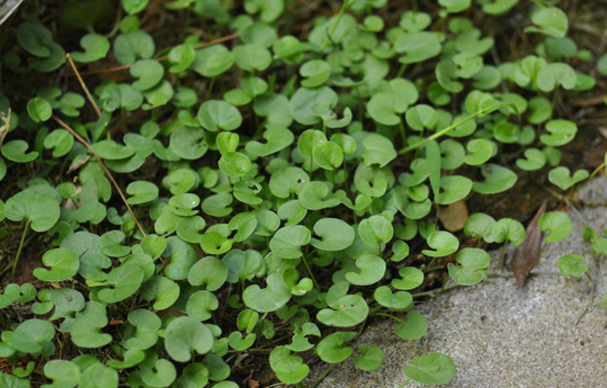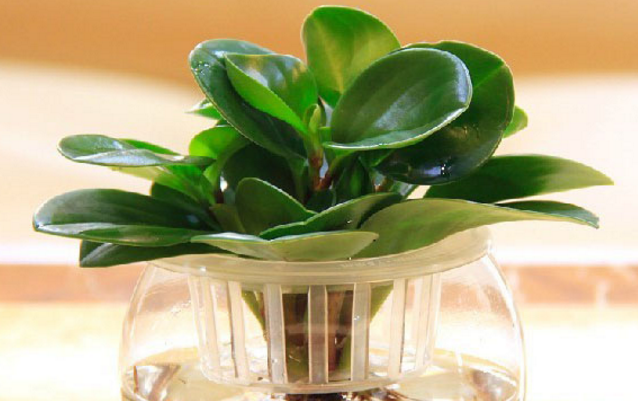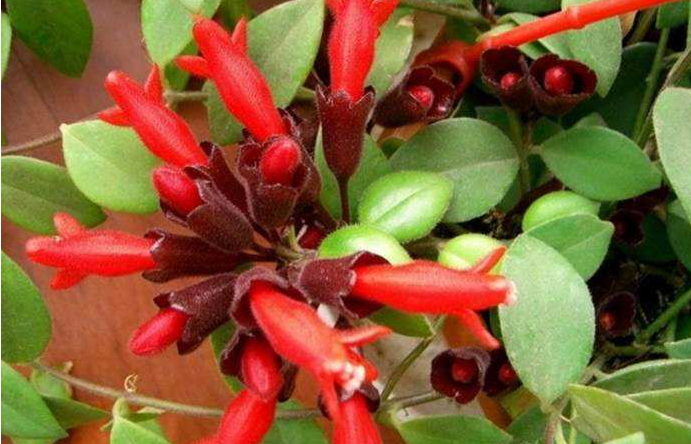What are the effects and effects of seed planting methods of Dichondra repens?
Small creeping perennial herbs, stems slender, gray pubescent, rooting at nodes. Leaves reniform to orbicular, 4-25 mm in diam., apex broadly rounded or emarginate, base broadly cordate, leaf surface puberulent, abaxially Adnate pubescent, entire; petiole long, petiole (1.5) 3-5 (6) cm long.
Flowers solitary leaf axils, petiole shorter than petiole, filiform; sepals Obovate-oblong to spatulate, obtuse, 2-3 mm long, abaxially and marginal hairy; Corolla campanulate, shorter to slightly longer than calyx, yellow, deeply 5-lobed, lobes oblong-lanceolate, glabrous; stamens 5, inserted in curved spaces between Corolla 2 lobes, filaments short, equal; ovary sparsely pilose, 2-loculed, with 4 ovules, style 2, stigma capitate.

1. The seed planting method of Dichondra repens should be sown from April to May in spring and from September to October in autumn. The best sowing time is when the soil temperature reaches 21 ℃. Sowing amount 10~15g/m soaked the seeds with 50mg/kgGA for 4 hours before sowing, the effect was better. Sow or sow the treated seeds on the prepared turf bed, then rake the seeds into the soil for 1-2cm, suppress them, and cover them with non-woven cloth or grass curtains, so as to increase the germination temperature and maintain soil moisture, promote the emergence of seedlings neatly and improve the emergence rate. 1. Soil preparation will loosen, rake and refine the ground so that the diameter of soil particles is below 2cm. Adjust the soil pH to 5.5-7.0. Disinfect the soil with formalin: water = 1:40, the dosage is 1015L per square meter of bed. The soil needs to be dry before disinfection. 2. Trenching and transplanting on the prepared turf bed to open a deep trench of 2~3cm, the distance between the trench and 3~4cm. Separate the prepared Dichondra plants and place them evenly in the ditch, keep the plant spacing 3~4cm, cover with soil 2cm, water once, cover with sunshade net or grass curtain, and keep the soil moist every day. On the 5th day of planting, the plant grew vigorously, but the stolons did not fully contact the ground and grow new roots; on the 10th day, a large number of stolons in full contact with the ground will grow new roots and buds. 3. Before planting covered with fine sand, the prepared turf was watered thoroughly, and the turf of Dichondra repens was torn off and spread evenly on the bed, and the prepared fine sand was evenly scattered on the top of Dichondra repens. The 6~10mm was thick, keeping the fine sand completely moist, and covered with sunshade net to prevent excessive evaporation of water. By the 5th day, a large number of new roots had grown on the stolon nodes of Dichondra repens, and on the 10th day, a large number of new branches had grown in the place where the new roots were born.
2. What are the effects and effects of Dichondra repens
1. Ornamental value of Dichondra repens
Dichondra is shaped like a horseshoe, with emerald green leaves, low plants, dense and beautiful leaves, resistance to mild trampling, exuberant vitality, strong resistance, wide adaptability, low requirements for growth conditions and no need for pruning. Dichondra is a kind of foliage plant, the small green leaves are very ornamental.
2. The landscaping value of Dichondra repens.
Dichondra has a long life, long green period, beautiful shape, easy to breed, easy to manage, and has the advantages of shade resistance and high temperature resistance. it is an excellent greening material for lawn grass and ground cover, which can be called "green carpet". It also has the function of fixing soil and protecting slope, greening and purifying the environment.
Dichondra repens has a high coverage rate and is very suitable for planting on exposed loess. It is an excellent ground cover plant, which is suitable for cultivation and ornamentation in parks, organs, courtyard green spaces, etc., and can also be used to make aloe plants on gully slopes, embankment slopes, roadsides and so on.
3. The medicinal value of Dichondra repens.
The nature of Dichondra is slightly bitter, sweet and frozen. Dichondra can be taken internally and externally. Treatment of jaundice, dysentery, sand, turbidity, edema, eczema, fall injury, snake bite and so on. It has the effect of clearing heat and promoting dampness, detoxification and detumescence.
Dichondra has the effects of protecting liver and lowering enzymes, as well as analgesia, anti-inflammation, antibacterial, antipyretic and cholagogic, enhancing immunity and anti-cancer. It can act on hepatitis, cholecystitis, dysentery, glomerulonephritis edema, urinary infection, urinary calculi, tonsillitis, fall injury. Making traditional Chinese medicine can also play a great role, but the medicine of Dichondra should be paid attention to. It can be seen from the "outline" that salt is prohibited. Therefore, we must follow the doctor's advice to avoid adverse reactions.
How to water and fertilize the seeds of Dichondra repens
Dichondra, this is also a kind of plant, is known by many people, but many people know it and can be hydroponically cultivated, so what is the seed planting method of Dichondra repens? How to water and fertilize:
Seed planting methods of Dichondra repens:
1. Land preparation
Do a good job in the topography of the land, where it should be high and where it should be depressed. Once the seeds are planted, it is not good to change the terrain. After determining the topography, remove all weeds and apply 3-5 tons of agricultural fertilizer per mu. The fermented chicken manure and cow manure are the best, and all the topsoil is ploughed once.
two。 Sowing seeds
After finishing the land, you can sow. The seeds of Dichondra repens are small and mainly sowed. When there is no wind, sow the seeds evenly, then cover the soil with a little positive pressure of 1cm to 2cm and cover with plastic film or degradable non-woven fabric after watering. If the temperature is good, germinate in about 10 days. after germination, pay attention to timely watering to accelerate the growth of shoots. Within 2 months of planting Dichondra, you need to weed manually. Remember not to use herbicides. Currently, no herbicide can be used on Dichondra repens.
The area of the courtyard garden is small, and the mechanical cultivated land is difficult, so it is generally used to turn the soil or spray water to sow seeds. If you can't turn the soil, remove the weeds and sow the seeds directly, but water them every day before germination to keep the seeds absorbing enough water to guide about half a month after germination.
How to water and fertilize Dichondra repens:
Watering is the key to the good growth of Dichondra. Dichondra is a plant with fine root system, which is not very resistant to drought and needs to keep the soil moist when breeding. In general, when raising Dichondra, it needs reasonable watering and often sprays water on the plants of Dichondra. Be careful not to lack water, which will cause Dichondra to lose its leaves and sparse branches and leaves, which will affect ornamental. When there is plenty of water, the Dichondra cultivated in the hanging basin will have thick branches and leaves.
Fertilization is also a very important step, Dichondra prefers nitrogen fertilizer, adequate fertilizer branches and leaves will grow more luxuriantly, but also easier to create a waterfall effect of hanging basin Dichondra. When raising Dichondra repens, nitrogen fertilizer can be applied in combination with watering, but do not pollute the leaves.
This is the end of the method of planting Dichondra seeds. Now you know how to water and fertilize.
Seed planting method of Dichondra repens
Dichondra repens can be propagated by sowing and ramet propagation.
Propagation method of Dichondra repens
This method is commonly used to breed. It is mainly propagated with its stolon. First of all, apply basic fertilizer, watering, intensive cultivation, leveling (or ridging) on the selected nursery land, the time can be from March to September. Then use the proportion of 1:8 to split the turf, tear the turf into 5cm × 5cm-sized pieces of grass by hand, stick them on the ground, compact them with a little soil, and irrigate them in time. Generally, after about 2 months of growth, it can cover the ground completely. After the stem segment is planted, when the new grass does not fully cover the ground, the weeds must be pulled out in time, usually 2-3 times.
Methods of sowing and propagation of Dichondra repens
Select the nursery, apply base fertilizer and pesticide (carbofuran 2kg/ mu), then plow carefully and build ridges. Sowing at the right time can be carried out from March to September of the whole year, and the best is from March to May. Before sowing, the bottom water is irrigated first, and then the selected seeds are evenly scattered in the human bed by sowing method, covering fine soil 1-1.5cm, and the sowing amount is about 3kg/ mu. Urea 5kg/ mu and diammonium phosphate l0kg/ mu were applied when 5 true leaves were grown. At this time is also the rapid growth period of weeds, we must timely remove weeds, control diseases and insect pests, is conducive to Dichondra lawn covered with the ground as soon as possible.
Step 1 of seed sowing and propagation of Dichondra repens L. sowing time
It is suitable to sow Dichondra repens in spring from April to May and in autumn from September to October.
2. Land preparation
The ground is loosened, raked flat and fined so that the diameter of soil particles is below 2cm. Adjust the soil pH to 5.5-7.0. Disinfect the soil with formalin: water = 1:40, the dosage is 1015L per square meter of bed. The soil needs to be dry before disinfection.
3. Trenching and transplanting
Open a deep trench of 2~3cm on the prepared bed, and ask the distance from 3~4cm. Separate the prepared Dichondra plants and place them evenly in the ditch, keep the plant spacing 3~4cm, cover with soil 2cm, water once, cover with sunshade net or grass curtain, and keep the soil moist every day. On the 5th day of planting, the plant grew vigorously, but the stolons did not fully contact the ground and grow new roots; on the 10th day, a large number of stolons in full contact with the ground will grow new roots and buds.
4. Cultivation covered with fine sand
Pour the prepared turf thoroughly before planting, tear open the Dichondra grass artificially, spread it evenly on the bed, and spread the prepared fine sand evenly on the bed, cover the sand 6~10mm thick, keep the fine sand completely wet, and cover it with a sunshade net to prevent excessive evaporation. By the 5th day, a large number of new roots had grown on the stolon nodes of Dichondra repens, and on the 10th day, a large number of new branches had grown in the place where the new roots were born.
- Prev

How to hydroponically cultivate rotten roots of Douban green?
Douban green can well adapt to the water environment, it can be hydroponically cultured, and it is easy to operate, so it is a lovely variety for beginners. Hydroponic Douban green shape is fresh and chic, put in a corner of the desk, do not have a lasting appeal. So what if Douban Green has rotten roots? don't worry, let's take a look at them one by one. How to cultivate Douban Green in Water
- Next

Lipstick hanging orchid soil culture method how to lose leaves?
Lipstick hanging orchid, this is a kind of plant, is good to see do not want, is really good-looking, the flower color is also quite gorgeous, lipstick hanging orchid soil culture method is what? Lipstick hanging orchid leaves how to do: lipstick hanging orchid soil culture methods: 1, soil selection: choose loose, fertile and well-drained soil
Related
- Fuxing push coffee new agricultural production and marketing class: lack of small-scale processing plants
- Jujube rice field leisure farm deep ploughing Yilan for five years to create a space for organic food and play
- Nongyu Farm-A trial of organic papaya for brave women with advanced technology
- Four points for attention in the prevention and control of diseases and insect pests of edible fungi
- How to add nutrient solution to Edible Fungi
- Is there any good way to control edible fungus mites?
- Open Inoculation Technology of Edible Fungi
- Is there any clever way to use fertilizer for edible fungus in winter?
- What agents are used to kill the pathogens of edible fungi in the mushroom shed?
- Rapid drying of Edible Fungi

